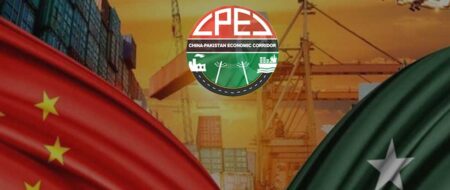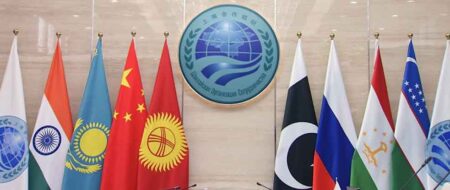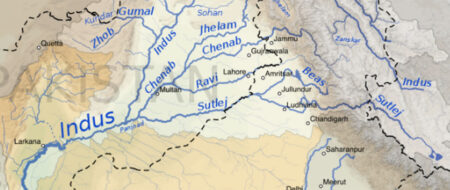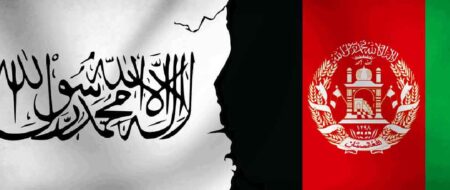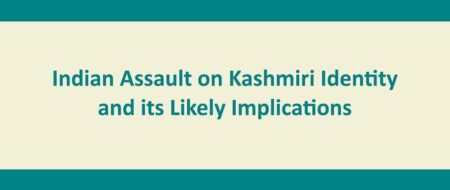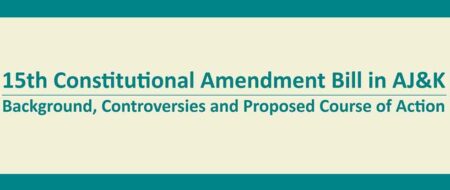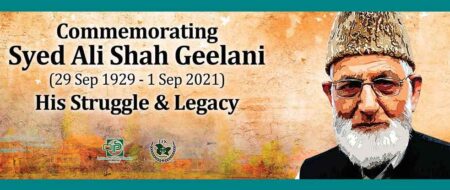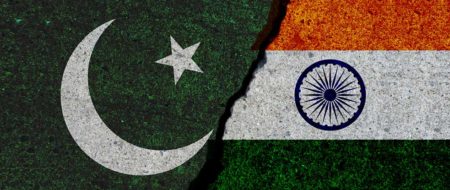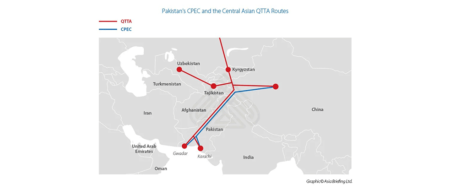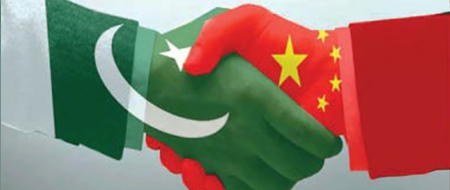Post-Cold War US Kashmir Policy
Policy Perspectives, Vlm 2, No.1
Abstract
Kashmir conflict in the post-cold war era
Kashmir suffered the most because of cold war alignments of Pakistan and India. During the cold war period, Moscow, on the behest of India, had always scuttled the possibility of a peaceful settlement of Kashmir dispute at UNSC by vetoing different resolutions on various occasions. The end of the cold war with the break up of the Soviet Union literally marginalized Pakistan in the US power corridors. Islamabad thus lost its strategic edge. In the meanwhile, nuclear proliferation rose high on the American agenda and Pak-US differences surfaced with new complexities. Excepting the period of joint campaign against Soviet aggression in Afghanistan (till 1989), US at every stage tried to prevent Pakistan from acquiring the nuclear technology. Islamabad was shaken by the US administration’s decision to impose complete ban on sale of military hardware and release of economic aid on October 1, 1990. This time, the US administration refused to issue a certificate saying that Pakistan did not have atomic bomb that had previously been issued as a pre-requisite under the Pressler amendment.
The fall of Soviet Union gave US more room to focus on economic development and venture for new investments and markets overseas. With this new mindset United States quickly entered in a new phase of cooperation and trade relations with its old rivals such as Russia, India and even China in 1990. Interestingly enough, the Indian government ignored the past allegiances and jumped into the American bandwagon. New Delhi even abandoned its traditional anti-capitalism stance and adopted an open market policy. Indian Prime Minister Narasimha Rao initiated a set of revolutionary economic reforms, which were very well received in Washington. The then Indian army chief said in Washington in July 1991, “In the new era, the Indian and US interests have converged’. Above all, India also provided fuel to the American Air Force from Bombay Air Base during the first Gulf War in January 1991 besides supporting all resolutions against Iraq on UN forum. This ‘new world order’ scenario thus marginalized traditional international backing and support for Islamabad.
In this changed global atmosphere, the Kashmiris started mass movement and the youth took up arms against the Indian rule in the disputed state of Jammu and Kashmir. Being a legitimate and recognized party to the Kashmir dispute, Pakistani people are emotionally attached with the Kashmiris’ ‘right of self-determination’ from day one. Understandably so, it was impossible for Islamabad to stay indifferent from the Kashmir struggle. The government and civil society extended their full support to the Kashmiris’ resistance movement, much to the chagrin of India and partly to Washington’s rage.
Meanwhile, the Kashmiri Diaspora, especially residing in the United Kingdom and the North America, got fully involved in the struggle. They formed lobbying groups and brought forth regional ethnic newspapers and magazines. Furthermore, the Jammu and Kashmir Liberation Front (JKLF) – a nationalist outfit – led the Kashmiri struggle in early 1990s, transforming the traditional outlook of Kashmir from a territorial dispute between India and Pakistan to a struggle for a Kashmiri self-rule with a sense of pride. Therefore, international community not only saw this struggle as indigenous but also offered media coverage enhancing popular interest in ‘whats and whys’ of the crisis.
Instead of addressing the root causes of the dispute, Delhi came out with a charge sheet against Islamabad for disrupting the law and order situation in the state. India also adopted a host of measures to suppress the mass resistance at various levels e.g. imposition of the governor rule; the enactment of several draconian laws like the Armed Forces (Jammu and Kashmir) Special Powers Act, 1990; Terrorist and Disruptive Activities Act (TADA), 1990; the Jammu & Kashmir Public Safety Act, 1978 (amended in 1990); and the Jammu & Kashmir Disturbed Areas Act, 1990. Rampant killing of innocent citizens became a regular feature in those days, which invited more and more of violence. This aggressive Indian strategy led to total alienation and revenge in Kashmiris’ against the Indians. In the meantime, India tried hard to get round the world that uprising in J&K state was a part of global wave of terrorism and fundamentalism.
The US response
In early 1990s, Kashmir virtually became the flashpoint amongst the disturbed regions of the world. The VP Singh government was threatening Pakistan almost every day. Inside the valley; the mass resistance against the Indian occupation was touching newer heights, thus making it imperative for the international community and United States to develop clear-cut positions vis-à-vis the Kashmir conflict. Like in the ‘50s when US was seriously involved in a bid to settle the dispute at different levels including the UNSC, it was not viable for Washington to sit quite.
Thus, Assistant Secretary of State for Near East and South Asia John H. Kelly made a testimony before the Asia-Pacific sub-committee of the House of Representatives and International Relations Committee on March 6, 1990 saying: “United States considers Jammu and Kashmir a disputed territory”. He urged both the countries to settle it according to the Simla agreement. Subsequently, US Ambassador to Pakistan Robert Oakley asked both the countries to “take into account the needs of the people of Kashmir.” The statement marked the beginning of US heed to Kashmiri’s resistance. The pronouncement obviously raised the expectations of the Kashmiri people.
1990 Indo-Pakistan Crisis
While the international community and US were involved in formulating the Kashmir policy, New Delhi drew its forces close to the Pakistani borders in the spring of 1990. The war seemed just around the corner, once again due to growing tensions over Kashmir. India moved more troops into the J&K to prevent the ‘cross-border’ infiltration from Pakistan and to intimidate hot pursuit or raids on ‘training camps’ in Pakistani territory. Meanwhile, some US intelligence analysts feared a possible nuclear exchange. The rhetoric had heightened so much that Indian Prime Minister VP Singh lashed out at Pakistan in the Parliament on April 10, 1990, warning against paying a heavy price for its acts. Likewise, a few weeks earlier his Pakistani counterpart Benazir Bhutto promised with Kashmiris in Muzaffarabad a ‘thousand-year war’ to support the resistance struggle.
Under these circumstances, while the chronic fire exchange across the LoC increased manifold, Pakistan implicitly threatened to use nuclear weapons if India intervened militarily across the Line of Control (LoC). Instantly, United States intervened to act as an intermediary. The first Bush administration sent its National Security Adviser Robert M. Gates to Islamabad and New Delhi respectively in a bid to lower the tension in the region. Besides, Senator Alan Craristion also visited both the capitals to warn them that the war between India and Pakistan would be a catastrophe for the people of both the countries. It could conceivably lead to the use of nuclear weapons and it would not resolve Kashmir problem. Gates mission thinned the war clouds over South Asia.
Nuclear Pakistan, Kashmir and Human Rights Issue
Near-war situation set out the alarm bells in Washington, which resultantly decided to force Islamabad to abandon its nuclear program and the Kashmir-specific mindset while it faced economic and military sanctions under the Pressler amendment. US ambassador’s warning to Pakistan manifests enormous diplomatic pressure on its one-time ally: “Pakistan is committing a suicide.” While pursuing their non-proliferation agenda, at times the American officials had set aside the diplomatic norms to behave like masters not friends.
The American diplomatic and economic pressure on Pakistan proved counter-productive and Islamabad became more dependent on its nuclear capability for the country’s security believing that only nuclear power could save it from the superior Indian conventional military might. The same would also help Pakistan continue its support to the Kashmiri struggle. The US attitude emboldened India to reject any conflict resolution deal with Pakistan.
Meanwhile, India and US started to echo each others’ views with regard to the ‘so-called’ danger of Islam. The Indians sensed the opportunity and they presented the Kashmiri resistance in the prism of Islamic extremism, fundamentalism and anti-America and west struggle.
America thus established linkages between Kashmir conflict and possible use of nuclear weapons. Outgoing President George W. Bush in his detailed briefing to his successor Bill Clinton categorically told him that the Kashmir conflict could take South Asia to war anytime. Bill Clinton (1993-2001) had assumed power in 1993 with the promise that his government would work for protection of human rights and non-proliferation all over the world. Ironically however, the Kashmiri people were passing through the worst human rights crises in their history. The Indian forces were applying indiscriminate terror tactics to silence the people. At this juncture, the Clinton administration took up nuclear proliferation and human rights issues simultaneously with Pakistan and India. Washington severely criticized Indian record of human rights violations in Jammu and Kashmir while pressurizing Pakistan to sign the NPT.
President Clinton established South Asian bureau at the State Department and appointed the then political councilor at the US embassy in New Delhi, Ms. Robin L. Raphel, as its head. The move hinted at the significance attached to South Asia by the Clinton administration. The first formal comment on part of the Clinton administration came in New Delhi when addressing the International Center Delhi, US Deputy Secretary of State Johan Malott held:
- The US considers all of Kashmir to be a disputed territory, on both sides of the line of control.
- This is an issue to be settled peacefully by India and Pakistan taking the views of the Kashmiris – both Muslims and non-Muslims into account.
- The US is prepared to be helpful in this process provided that it is desired by the two sides.
- The US also urges genuine access to rights groups “to shed greater light on human rights abuses from all sides.
Significantly, the statement marked a striking shift in US policy, giving the Kashmir question an unprecedented urgency and even a new streak of legitimacy. Hardly a month later, US House of Representatives censured India for its human rights violations in the occupied Kashmir, the Punjab and Nagaland.
The first year of Clinton rule was a nightmare for India. Not only diplomats and government officials were critical towards the Indian human rights record, the president himself told the United Nations General Assembly annual session: “As we marvel at this era’s promise of new peace, we must also recognize the serious threats that remain.” He observed, “Bloody ethnic, religious and civil wars rage from Angola, Caucasus to Kashmir.” The mood in Islamabad and the Kashmiri circles was upbeat while India was annoyed by Clinton’s referral to the Himalayan state as a major trouble spot. Referring to the Indian criticism, Robin Raphael not only defended her president’s comments but also went a step ahead, saying: “It was meant to say, we see Kashmir on radar screen along with Yugoslavia and Somalia and lots of other places in the former Soviet Union, Georgia, where there is civil conflict going on. We cannot easily overlook it, and there is a message in that.
As US had put prevention of human rights violations, nuclear non-proliferation and sustainable development and economic liberalization on its new agenda, Kashmir became a test case for America to show its commitment and adherence to the notion of human rights protection.
Robin Raphel severely criticized human rights violations by the Indian forces in Kashmir, saying:
“Making people disappear, encounter killings, extrajudicial executions, death in custody, and all this stuff, frankly, there is no excuse for. We view Kashmir as a disputed territory and that means we do not recognize the instrument of accession as meaning that Kashmir is forever more an integral part of India.”
Apart from Robin Raphel, some other key US policy institutions also criticized the Indian record on human rights violations. For instance, in August 1993, the House Sub-Committee on Asia and the Pacific reviewed the Kashmir situation and observed:
“There is a growing consensus that some Indian security forces have engaged in widespread human rights abuses in Kashmir against the insurgents and civilian population, which is majority Muslim. Unfortunately, the number of such abuses including rape, reprisal attacks against civilians, summary executions, systematic arson, and attacks on medical personnel and human rights monitors has increased dramatically in recent months. The Subcommittee calls upon the government of India to impose civil and criminal sanctions on those responsible for human rights abuses.
Just a month later, the US Senate Foreign Relations Sub-Committee asked India to stop “deliberate killing of unarmed civilians and end the impunity for gross violations of human rights by the security forces.” The Committee’s report also stated that “it is disappointing that, to date, the International Red Cross (ICRC) has not been permitted access to Kashmir.”
A number of Congressmen off and on raised the issue of Kashmir with particular reference to the human rights situation in the Valley. India Today’s Washington Correspondent Tania Anand writes:
“More and more Congressmen are resorting to anti-India diatribes on the floor of the House. So concerned are Congressmen about being seen to be on the right side of human rights that even those elected with Indian support don’t hesitate to disown India when it comes to issues like human rights.”
It was really a big success for the Kashmir resistance struggle that US eventually had came up with a clear policy, at least on the issue of human rights. Islamabad and the Kashmiri circles were expecting that other countries would also follow the lead and support the Kashmir cause.
Washington Changes Track
Frequent American criticism of the Indian human rights record put New Delhi on back foot besides slowing down the pace of the fast growing Indo-US relations. The Congress government and Indian media were angered by the US advice on human rights and particularly for reference to Kashmir conflict by various officials of the Clinton administration. At the same time, Narasimha Rao-led India realized the economic, military and diplomatic power of the US. New Delhi decided not to antagonize the US as it could harm her interests and reduce future options. Nuclear expert K. Subrahmanyam advised his government:
“As the sole superpower, only the US is in a position to guarantee India’s security concerns. The break-up of the Soviet Union has lost India the leverage it traditionally enjoyed with the US. In a unipolar world, a hostile antagonistic America can only benefit Pakistan and undermine India’s security. In addition, US support for concessional financing from the International Monetary Fund and the World Bank is critical for the country’s economic reforms program. Finally, India needs the US to acquire advanced technology in key areas like electronics, space research and telecommunications.
Indian Prime Minister P.V. Narasimha Rao took added interest in improving relations with US. He personally encouraged the Indian-Americans to invest in their motherland and work for its image-building overseas. In the meantime, he liberalized the Indian laws to develop investment-friendly environment. The reforms earned good repute and the US Commerce Department named India as a big emerging market (BEM). Till May 1993, US investment in India had crossed over $1.1 billion, apart from a similar expansion in bilateral trade.
Furthermore, to allay Washington’s criticism, the Indian government took some reconciliatory measures such as setting up of human rights commission and access to the ICRC to visit IHK. Moreover, they released prominent Kashmiri leaders and invited Islamabad for talks on conflicting issues. The Indian government left no stone unturned to appease Robin Raphel during her four-day visit to New Delhi in March 1994. Rao’s Home Minister S.B. Chavan, who had previously declined meeting with Raphel, terming her a ‘junior office,’ not only gave her waited for his meeting but also personally supervised arrangements of her visit. Furthermore, the Rao government also told the Americans that the Agni missile program was over and the Prithvi had slowed down. It was a signal to the US administration that India can cooperate on the nuclear issue and missile development program.
Indian Efforts Bore Fruits
Before leaving New Delhi, Raphel had a long chat with a select group of journalists. She spelled out US polices in five points:
- We support a negotiated end to the conflict in Kashmir. Our focus is not how it started, but in how it can be ended.
- We support efforts to resolve the dispute as envisaged in the Simla Accord.
- We support Prime Minister Rao’s efforts to pursue a political process that will bring to an end the fighting in Kashmir.
- We are concerned about credible reports of human rights violations in Kashmir. We always acknowledge that militants share responsibility for violations with the security forces. We appreciate the steps the Government has taken to reduce the abuses committed by members of the security forces.
- We vigorously oppose outside aid to the militants and have repeatedly made that clear in capitals where it needs to be heard. We have worked harder than anyone else to decrease that support.
This statement cleared the mist and allayed misunderstanding about the US intentions paving the way for Rao’s May 1994 visit, which later played an instrumental role in improving Indo-US relations. It was a calculated and well-managed trip. Rao spent a lot of time on mock exercises to develop various scenarios while dealing with the American president and his aides. Besides, he focused on business and trade relations. For this, he took along top Indian businessmen and traders to the United States. On the other hand, the American investors formed India Interest Group, a lobby of 26 American parlances as ‘heavy hitters,’ such as AT&T, Coca Cola, IBM, General Motors and other corporate giants. In the US power structure, big business plays a major and significant role. They say: “If big business talks, White House listens.” Before starting formal meetings with the US officials in Washington, he paid a visit to the key business centers of US such as New York, Houston and Boston. Everywhere, Rao tried hard to sell business opportunities in India. Now, he was able to push the economic agenda of his visit to the centre stage instead of facing controversial questions. In fact, he successfully made headway in the American policy circles. After summit meeting, Clinton told Rao, “Suddenly, all my cabinet members want to visit India.” His visit sidelined the issues of human rights and Kashmir as America avoided talk on Kashmir or human rights record publicly.
Slowly but surely, Washington put Kashmir and human rights issues on the backburner and gave preference to the economic relations. Meanwhile, the State Department claimed in its annual report on the human rights that militants were also responsible for human rights violations. With this new found phrase, US started to encourage political process in the IHK. President Clinton advised India:
“ … to work to reduce human rights violations, allow greater access by international organizations and encourage political dialogue in Kashmir that would lead to the restoration of credible democratic process.”
Following this statement, US almost stopped criticizing New Delhi and started to appreciate for taking different steps to improve ground situation. For instance, in one congressional testimony Ms. Raphel cited the formation of a National Human Right Commission in India, as well as the Indian Army’s crackdown on its own soldiers as steps ‘in the right direction.’ She justified her government’s new stand and remarked:
“… The United States has multiple interests – democracy, human rights, commerce, stability, etc. – and it pursued them all ‘in an appropriate way’ without trading off one with another. Situation in Kashmir today is lot different than what it was in 1993. Indian had taken a number of steps, including the establishment of a human rights commission …”
Diluting its traditional position on the nature of Kashmir dispute, the US advised Islamabad to forget about history and see ahead. It even ruled out the possibility of UN resolutions’ implementation. While giving briefing to House International Relations Sub-Committee on Asia and Pacific, Ms. Raphael observed:
“… To be fair, I think it is a little bit more complicated. The earlier UN resolutions called for a plebiscite and some Kashmiris and the government of Pakistan over the years urged that those resolutions be implemented. The difficulty is that a lot of history has gone by since that time, number one. Number two, the government of India at this time doesn’t share the view that those resolutions are still relevant. And third, in practical terms, as I said in my statement, it is time to move forward, not to look to past prescriptions but to come up with a prescription that fits the situation on the ground and current political reality …”
Furthermore, immediately after Rao’s visit, the State Department appointed Frank G. Wisner ambassador to India. He was a career ambassador and well-connected in the US power corridors. Before assuming office, he said he would work on non-proliferation and Kashmir in an overall framework of friendship and cooperation. He also made it clear that the United States did not aspire to play a role in the Indian and Pakistani problems.
All these statements indicate that economy and national interest prevailed over the notions of human rights and right of self-determination. Islamabad and pro-freedom circles in Srinagar got disappointed with the new US approach towards India and its cold attitude towards Kashmir issue. This US approach vindicated the extreme right wing skeptical viewpoint about Washington that US would not support right of self-determination in Kashmir for it were the Muslims who were demanding that.
US support to J&K State elections
Since the early 1990s, New Delhi had been trying to initiate political process leading to state elections but was unable to implement its plans due to a host of unfavorable internal and external factors. During 1995 and early 1996, New Delhi faithfully established contacts with a number of groups involved in Kashmiri militancy and encouraged them to play to the Indian game plan. These renegades formed militant outfits and killed and maimed thousand of civilian supporters of Kashmiri resistance. Many political workers and human rights activists were killed by the counter militias. Through these unlawful tactics, India apparently got an upper hand on the armed resistance. It took benefit of the situation and announced to hold elections in September 1996.
Strangely enough, US ambassador Frank G. Wisner pushed the elections idea and started a campaign in its favor. He personally met with several Hurriyet Conference leaders in a bid to convince them for participation in the elections. When the Kashmiri leaders apprised him about their stand and legal complications in taking part in elections i.e. one has to take oath to remain loyal to the Indian constitution, he even assured them that in case of their readiness to participate in elections, India would not ask them to take oath. Interestingly, this offer should have come only from the Indian authorities or election commission. Following statements may help understand US’ key functionary’s approach towards state elections:
- The state elections must be free, fair and open and I am assured by the Government in Delhi and that of state itself that they will be. They are not an end in themselves; indeed many Kashmiris will not participate. But to the degree that elections have been preceded by political dialogue and are followed by further dialogue between Kashmiris and between the state and the central government over a fresh constitutional definition, then a process is underway that offers promise to India, to the region and the world.
- The United States will continue to express its support for a political process in Kashmir and a resumption of dialogue between India and Pakistan as we have done for over 40 years.
- The upcoming elections in Jammu and Kashmir State “offer hope for an end to the seven-year Muslim insurgency. There is a political window of opportunity for Jammu and Kashmir for the first time after years of nightmarish violence.
Likewise, Wisner said in Srinagar that the Hurriyet leaders were ready to participate in the elections. The Hurriyet immediately condemned the statement and canceled its scheduled meeting with Wisner. Not only Wisner but US senator Hank Brown, author of the Brown amendment, also visited Srinager and urged Kashmiri activists not to boycott the elections. Wisner also visited Islamabad in May 1996 to explain to top Pakistani leaders his views on the political process in J&K state. He asked Islamabad not to support anti-elections moves in J&K and praised the Indian efforts to bring peace to Kashmir.
Pakistan and the Kashmiris sharply denounced Wisner’s pro-elections campaign and the people boycotted the elections. Pakistani Foreign Minister Asif Ahmad Ali commented on Wisner’s remarks in a very critical way: “Wisner is acting as a devil’s advocate.” He said Wisner ignored the ground realties and his statements did not reflect US official policy. It was however a classic example of the American double talk and policy on the Kashmir issue. While Wisner was advocating and garnering support to state elections, another US top official Robin Raphel stated diametrically contradictory views, she remarked that the elections were no substitute for a plebiscite.
Contradictory statements generated confusion among different stakeholders and everyone was asking what Americans were really up to? Washington supported the state elections and political process initiated by the New Delhi while it also regarded Kashmir as a disputed territory. These double-edged policies however, bolstered New Delhi to hold fake elections and get international acknowledgement. This also encouraged India that it should not see the Kashmir solution beyond the current territorial arrangements. Frustrated from pro-India US stance over Kashmir elections, Kashmiris continued their armed struggle irrespective of the fact that Washington-led world ignored their genuine desires. This situation further fueled militancy and marginalized the political and pro-peace lobby both in Islamabad and Srinagar.
Kashmir and terrorism
At another level, India was persistently trying hard to make the world believe that the Kashmiri struggle is part of anti-America global jihadi network. US and the western world generally did not buy this argument till the mid-‘90s. However, various internal developments strengthened the impression that the Kashmiri resistance was also part of global terrorism.
In August 1998, US held Osama Bin laden responsible for attacks on US consulates in Nairobi, Kenya and Tanzania. In revenge, US fired cruise missiles on Osama Bin Laden alleged camps’ in Afghanistan and Sudan on Aug. 21, 1998. Media reports suggested that six members of Harkat-ul-Mujaheedin also died in Osama’s training camps in Afghanistan due to US missile attacks. Harkat-ul-Mujaheedin was an active and prominent Jihadi force in Indian held Kashmir, its leader Fazl-ur-Rehman Khalil was considered a very close friend of Osama. The Indian agencies claimed that Fazl-ur-Rehman also signed the petition of Osama to attack American and other western nations’ installations. Besides, the Harkat-ul-Mujaheedin was also accused of kidnapping five foreign tourists in 1995 who were later assassinated under the fake name of Al-Faran.
Meanwhile, with the abandoning of militancy by JKLF in 1994, the leading secular and liberal voice in the armed struggle was also gone. Islamic ideology of jihad was very much prominent in operations and manifestation of other organizations. This helped India to give its long desired twist to whole struggle of Kashmir as part of fundamentalism/terrorism.
In the wake of American attitude towards Taliban and Bin Laden, India exaggerated the Taliban threat and linked Kashmiri militancy with Osama Bin Laden school of thought. In addition, criticism on Taliban government and Kashmiri freedom movement became a recurrent theme in Indian media and officials’ discourses. Basic objective of this venture was to link terrorism and fundamentalism with Kashmir struggle in order to get support of western countries in favor of India. As a result after 1999, US government and other non-governmental organizations started linking terrorism with Kashmir liberation movement.
Nuclear Explosions and Kashmir
True to its established anti-Pakistan image, the BJP government after winning the 1998 elections decided to test nuclear devices on May 11, 1998. It incorporated the nukes as part of its national defense system. The Indian tests left Pakistan with no option but to conduct its own tests. Since the Kashmir was being widely termed as ‘nuclear flashpoint’ that time around the world community took these tests in the context of the long-standing dispute of Kashmir between the two countries. India itself linked the Kashmir issue with nuclear explosions by declaring that Pakistan must withdraw its forces from Azad Jammu & Kashmir and accept the ground realities i.e. the Indian nuclear capability. Sense of superiority was apparent amongst the Indian leadership. The western observers widely viewed Pakistan’s May 28 tests of six nuclear devices as a response to Indian threat of targeting aimed at Pakistan and Azad Kashmir. The Washington Post noted that “Pakistan’s nuclear tests internationalize the Kashmir dispute and bring it back on the active agenda of the United Nations.” President Clinton stated that Kashmir is the core dispute in South Asia and that without its settlement durable peace cannot be achieved in the region.
US Secretary of State Madeline Albright said: “We believe that domestic politics and the Kashmir problem played a role in Indian decision to detonate … Kashmir is the basic problem that causes tension in South Asia.”
Some other American officials also expressed the fact that Kashmir was the basic reason behind nuclear explosions and antagonistic relations between Indian and Pakistan. The international community, already cognizant of the natural linkages between the Kashmir issue and atomic explosions, also voiced its concern in different ways. United Nations in its Security Council’s resolution 1172, Sino-American declaration and Nelson Mandela in his speech in inaugural session of Non-Alignment Movement conference, all stressed on the resolution of the Kashmir issue. After the atomic explosions, Kashmir Study Group comprising influential American intellectuals and former ambassadors, in its report titled Kashmir: A Way Forward, suggested different proposals for the resolution of Kashmir conflict. President Clinton told the United Nations 53rd General Assembly session: “Resolution of ancient animosities in Kashmir is a must which is killing innocent people.”
Kargil Crisis
Pakistan’s nuclear tests response changed the Indian attitude and it initiated the dialogue with Pakistan. On February 1999, Vajpayee traveled to Lahore to inaugurate the bus service from Lahore to Delhi, where he met with his Pakistani counterpart Nawaz Sharif. The joint declaration issued after their meeting stated agreement between the two leaders on discussing all issues. Vajpayee’s visit to Lahore offered hope for reduction in existing tension and animosity between the two countries. The media in particular created such an atmosphere that it was widely believed that the visit would lead to some visible progress on contentious issues. Though, Vajpayee and other top Indian officials issued contradictory statements from Delhi, creating doubts about the end result of these talks but the international community and a number of people from both the sides started expecting that significant developments may take place.
The Kashmiri freedom fighters and the resistance leadership however monitored these developments with suspicion and openly expressed dissatisfaction with the entire process. In order to once again draw the world attention, pro-resistance circles at various levels believed that it was the time to take new steps to pressurize the Indian forces and also satisfy the feelings of their masses. The proposed action was also aimed to get a breathing space from the sufferings at the hands of Indian forces in the occupied state.
Interestingly, the Pakistani forces were continuously receiving information that India was trying to conduct a big operation in Shaqma sector. Given the fact that India had already captured some Pakistani controlled areas of Kamar and Siachin in 1970s and mid-1980s, the Northern Areas Force Command (FCNA) had established their posts in Pakistani frontline areas to counter any adventure from Indian side.
In this backdrop, on May 7, 1999, India accused that Pakistan had violated the LoC and had created its posts in Indian occupied Laddakh region. While the Pakistanis claimed that the posts were established within their own areas. India did not accept Islamabad’s position and declared to take serious steps.
India deployed 80,000 soldiers from Mushkoo valley to Batalik region; spread over 100 miles of rugged Kargil district. More than 1,000 porters from Nepal and all over India were deputed to transport food, water and other materials to the hilly outposts. Thousands of heavily armed Indian troops had moved into Kargil and Drass through shell-scarred highway, reopened in May, after the Himalayan winter ice melted. For the first time since the uprising began, India used air force against the militants to capture these posts. During May and June 1999, the two sides were locked in a bloody battle in the Kargil sector. There was clear indication that a full-fledged war may erupt in South Asia.
The American involvement
When the tension between the two nuclear rivals became too pronounced, the international community, especially America started its diplomatic efforts to avert a possible war. American President Bill Clinton demanded withdrawal of Pakistani-backed forces from the Kargil sector.
The pressure further increased when Principle Secretary to Indian Prime Minister Barjesh Mishra traveled to Geneva, where he met with participants of G-8’s Annual conference and American Security Advisor Sandy Berger and handed over Vajpayee’s letter for President Clinton. The letter made it very clear that if Pakistan refused to withdraw its forces form Kargil, India would attack Pakistan.
Vajpayee’s letter got the desired objective since immediately after that the American president stressed upon the G-8 countries to ask Pakistan for withdrawal of troops from Kargil. In this context, the conference declaration accommodated the Indian point of view on ‘infiltration’ and asked Islamabad to respect the line of control.
On his way back to Washington from Geneva on June 23, President Clinton sent General Anthony Zinni, Commander-in-chief of Central Military Command and Deputy Assistant Secretary of State for South Asia G. Lanpher as personal envoys to Islamabad, where they met Prime Minister Nawaz Sharif, the then Chief of Army Staff General Pervez Musharraf and other important government officials. General Zini conveyed a message from the American president asking Pakistan to withdraw the forces unconditionally from Kargil. Zinni implicitly threatened, “The US would not bailout Pakistan if India decided to launch a major attack across the Line of Control.” The US also threatened to block a $100 million tranche of an IMF loan to be disbursed to Pakistan soon. The G-8 countries sent an even tougher private message to Sharif threatening to suspend all multi-lateral and bilateral aid.
The Pakistani side demanded of the Americans to adopt a balanced Indo-Pak policy, and do not de-link Kashmir and the Kargil from each other. According to the Pakistani sources, Islamabad had conveyed its point of view to Washington through General Zinni and Pakistani negotiators were expecting a positive and balanced approach from America. Chief of Army Staff General Pervez Musharraf referred to the possibility of meeting between Nawaz Sharif and Clinton on Kashmir issue. General Musharraf assured the nation that there would be no unilateral withdrawal of forces. Also, an optimistic view among the pro-resistance circles was that America would convince India to reciprocate and discuss Kashmir issue after withdrawal of troops. However, it was not so. Even Washington refused to subscribe to the Pakistani point of view on the issue, let alone resolve the Kashmir conflict. During the visit of General Zinni, State Department spokesperson James Rubin in a one-sided tone said: “We want to see withdrawal of forces supported by Pakistan from the Indian side of LoC.” Recently published accounts on the crisis also suggest that Clinton administration was not only unsympathetic towards Islamabad’s position but also arrogant. In the process, it became quite obvious that the real US intent was not to play a neutral mediator’s role. Various military commanders in their interviews insist that it was the US that prevented India from coming to the negotiating table with Pakistan at the time.
Pakistan was then left with limited options and ultimately Sharif decided to go to Washington with a view to finalizing the ways and means of defusing the crisis. Following a three-hour meeting between US President Bill Clinton and Pakistani Prime Minister Nawaz Sharif in Washington on July 4, 1999, the two leaders issued a joint statement that declared an end to the Kargil crisis. The statement included an agreement between the two leaders on the following issues:
- Respect for the LoC in Kashmir by India and Pakistan in accordance with the Simla Agreement;
- Withdrawal of infiltrators from the Indian part of Kashmir without any pre-conditions, and;
- A bilateral framework for future negotiations between India and Pakistan
The Clinton-Sharif statement accommodated all the Indian demands. After this joint statement, forces in the forward positions accepted Sharif’s request. Withdrawal took place but practically speaking, no progress was seen on the Kashmir front despite the American president’s commitment to help resolve the conflict. India became more and more intransigent and hard on the issue. Indian Foreign Minister Jaswant Singh said: India will never enter into discussion with Pakistan, until Pakistan stops its support for militants and cross border infiltration.
Complete details of American role regarding Kargil war are still a mystery. However, apparent developments indicate that America avoided to make use of the chance for making any efforts towards resolving the issue. The Pakistani leadership could not withstand the American pressure and gave up the Kargil operation. Had America not pressurized Pakistan, the crises may have continued for a few more weeks. This in turn would have forced the two sides to strike a ceasefire followed by negotiations.
Following important points regarding the American behavior on Kargil are worth noting:
- Pakistan was held responsible for Kargil war. Initially privately and later publicly, the US made it clear that it viewed Pakistan responsible for the whole crisis. With regard to resolution of the crisis, President Clinton’s Advisor on South Asia in the National Security Council, Bruce Riedel, made it clear that “those who infiltrated from the Pakistani side to Indian (side) must go back.”
- The US also indicated that if Pakistan continues to display intransigence, Washington might be forced to accept a possible Indian retaliation across the LoC in Kashmir.
- Another important development was that Washington showed firm opposition to the internationalization of the Kashmir question and did not support Pakistan’s attempts to bring it before the United Nations Security Council.
- The US position on the Kargil issue coincided with that of India. Washington was also ready to work for a solution that would satisfy the Indian demands.
- By any adventurism, Islamabad can neither force India to negotiations table nor can it get US support.
Clinton’s Visit to India and Pakistan
In March 2000 Clinton decided to visit India for five days. It was after a long time that a US president was visiting the region. Initially Pakistan was not included in his itinerary. But Pakistani Ambassador to Washington Dr. Maleeha Lodhi and the Pakistan Diaspora jointly pressed Clinton to include Islamabad into his proposed visit of South Asia. The President willy-nilly agreed to oblige Pakistan and stayed at Islamabad for about five hours.
Among other issues, Kashmir remained focal point during Clinton’s visit to India and Pakistan. Sadly, during Clinton visit to India, some unidentified people killed 35 Sikhs in the Indian held Kashmir. The tragic incident while highlighting the Kashmir conflict also helped India to once again accuse Pakistan and the militants for these killings. Pakistan refused the allegations. Kashmir however, remained one of the major point of discussions during the visit, such as Clinton’s speech to joint session of Indian parliament, his interaction with media and, his address to people of Pakistan through television and radio in Islamabad.
Clinton stated that conflicts cannot be resolved through violence, and line of control must be respected. He also categorically stated that there are certain elements in the Pakistani administration which are supporting Kashmir struggle.
After Clinton’s visit, the American position can be explained under these points:
- Pakistan must forget the past and focus on future developments.
- Implementation on UNSC resolutions is not possible now, but the legitimate grievances of Kashmiris should be addressed.
- America is not to mediate on Kashmir issue unless requested by both the parties.
- Line of control must be respected.
- Section of Pakistani establishment is helping Kashmiri militants.
- Solution to Kashmir cannot be achieved through militancy, Pakistan must find out some non-violent ways to discuss the matters with India.
- India must start negotiations with Kashmiris in order to solve the problems and must realize that use of force may not be able to solve the issue.
Kashmir after 9/11
Right after the 9/11 attacks on key US installations, the American president and the entire US establishment held al-Qaeda and Taliban responsible for the incident. US President George W. Bush declared new order for the world, he said:
“Every nation in every region now has decision to make: Either you are with us or you are with terrorists. From this day forward, any nation that continues to harbor or support terrorism will be regarded by the United States as hostile regime.”
Sensing an opportunity, the government as well as the opposition parties in New Delhi started persuading the US forces to eliminate Taliban and teach Pakistan a lesson. Vajpayee convened an all parties conference to apprise the national leadership on the new global situation on Sep 15, 2001. All shades of political opinion but the Communist Party of India asked Vajpayee to tender all required facilities to Washington. In the meantime, the Indian officials tried to make it a point that Pakistan was the main instigator of the terrorism and world should act against Islamabad so that the ‘root cause’ of terrorism could be eliminated. Further, India bracketed armed struggle in Kashmir with tragic attacks of 9/11. Two days after the 9/11 incidents, Vajpayee spoke to the nation and painted India as a decade-long victim of terrorism that had then manifested itself so viciously in New York and Washington.
Unique geographical location and Islamabad’s association with the Taliban made Pakistan venerable before Washington. Straight away, the Bush administration demanded full cooperation against Taliban and al-Qaeda. India took the benefit of the situation and offered full cooperation and support against Taliban regime while Islamabad was about to make the decision. The Indians offer left limited room for Musharraf regime to maneuver. Initially, Islamabad tried all its options to get round the Taliban to handover Osama Bin Laden to United States, so that their government could be secured but they refused to budge even a single inch in this regard. In this background, Pakistan opted to cooperate with Washington. General Musharraf spelled out the following reasons for his decision to support US-led military invasion of Afghanistan:
- No one would force Pakistan to operate outside the country borders
- Future dispensation in Kabul would be Islamabad-friendly
- Kashmir would not be linked with terrorism and no action would be taken against Kashmiri freedom fighters
- Pakistan’s nuclear and missile programs would be protected
New Delhi got frustrated when it realized that despite explicit offer of all kinds of cooperation US did not want to take benefit of Indian generosity due to Islamabad’s unwillingness. The Indian strategic experts were well aware of the impact of Islamabad’s inclusion in the newly-founded coalition against terrorism. They had understood that it would be an opportunity for Pakistan to break long imposed diplomatic isolation and at the same time to use its influence to garner support on Kashmir issue. Above all, it may not be possible for the United States to maintain the current momentum of its ‘strategic relationship’ with New Delhi.
Caught by surprise, the Indian officials and media commentators initially got infuriated but later tried to agree on a framework for Pakistan-US relationship. New Delhi wanted to get guarantees that new alliance would not be harmful to the Indian interests. At times, India tried to sell the idea that al-Qeada had expended its network to the disputed state of J&K. Even top Indian officials tried to sell this theme to US administration. Under the guise of Indian state-backed propaganda, US Defence Secretary Donald Rumsfeld said, “I have seen indications that al-Qaeda is operating in areas near the LoC.”
Meanwhile, attacks on Srinagar legislative assembly (Oct. 28, 2001) and Indian parliament (Dec. 13, 2001) changed the entire spectrum of Pakistan-India relations within two month after 9/11 incidents. New Delhi termed Jaish-e Muhammad responsible for the attacks and blamed Pakistani intelligence agency ISI for masterminding the attacks. The Indian Prime Minister, other leaders and officials pledged on a number of occasions that they would teach Pakistan a lesson. New Delhi brought its forces along the Pakistani border and the LoC within weeks after the attack. It also handed over a long list of demands to Islamabad and withdrew its high commissioner from Islamabad. New Delhi described these steps as coercive diplomacy. On the other hand, India launched a systematic and coordinated psychological propaganda war against Pakistan. Above all, the Indian forces were in a ready-to-attack position. Vajpayee visited forward posts at Kupwara, neighboring district of Muzaffarabad and threatened Islamabad:
“The time has come for a decisive battle and we will have a sure victory in this battle. Whether Pakistan or the world take note of it or not, a new chapter of victory and triumph will be written in the history books soon. The enemy has thrown us a challenge by waging a proxy war. We accept it and pledge to give it a crushing defeat.”
Islamabad refused to admit that it was involved in the attacks. It claimed that Indian government managed all these incidents to defame it. Above all, Pakistan held that this was a deliberate move, taking place amidst the global ‘war on terror,’ to threaten the use of force against Pakistan. Moreover, in response to Indian army moves along the border, Pakistan also moved its troops to the forward lines. All these developments created an extremely tense situation on the borders and it was almost certain that the war loomed large on region.
The US role
Despite the ten-month long border tension (Dec. 2001 – Oct. 2002) – the longest period of military mobilization by the two sides since their independence in 1947 – war did not break out. There is no denying of the fact that during the standoff, US played a vital role to defuse the tension and restart the negotiations between the two countries. Caught in a very peculiar situation, both the countries expected US to side with them at the cost of the other. Delhi was demanding that the US should help pressurize Pakistan to cease cross-border infiltration of militants across the LoC. While Islamabad urged the US to keep Delhi away from military action.
The United States vigorously persuaded its own agenda by asking India for restrain while putting maximum pressure on Pakistan to end its support for the Kashmir struggle. It was important for US as it was not affordable for it to let international attention divert towards other issues except war against terrorism. To appease India, President Bush himself announced a ban on Lashkar-e Taiiba on Dec. 21, 2001 and later on praised Musharraf’s steps against militancy. In an attempt to reduce tension, US Foreign Secretary Powell visited the two countries in January 2002. The US urged both sides to reduce tensions while continuing to maintain that it would play no role in the resolution of the Kashmir dispute. Deputy Secretary of State Armitage said the US has had discussions with India ‘about the need to be balanced and measured.’ US-Pakistan discussions focused ‘additionally on the need to stop cross-border terrorism.’
Several officials urged Pakista


